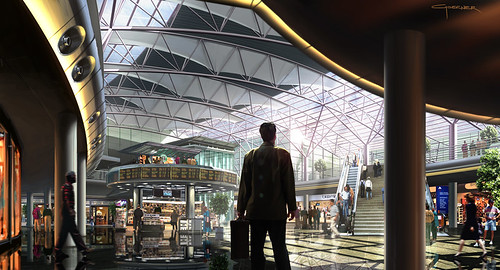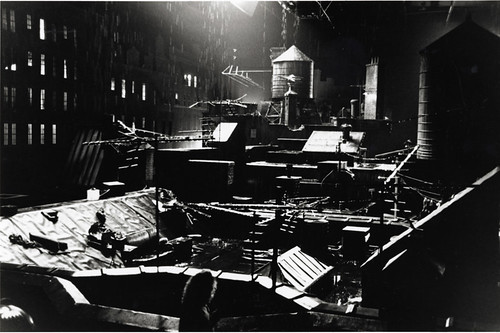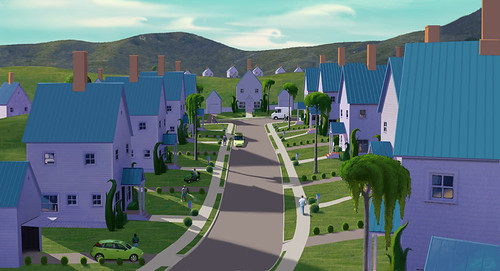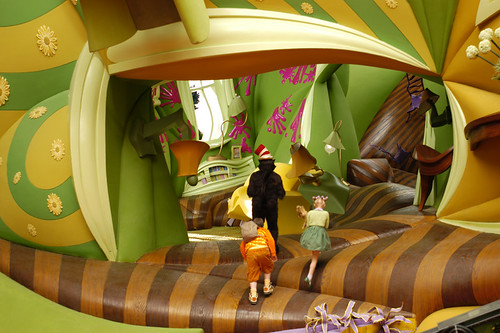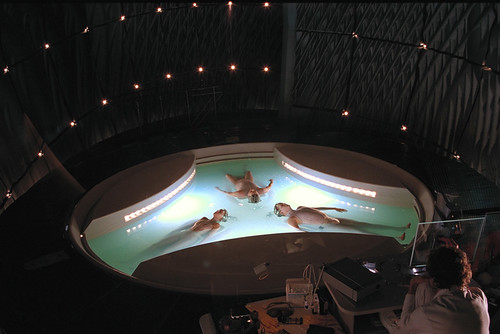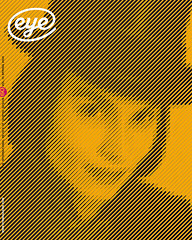Summer 2006
LA art school
From Punk to production design: the widescreen career of Alex McDowell
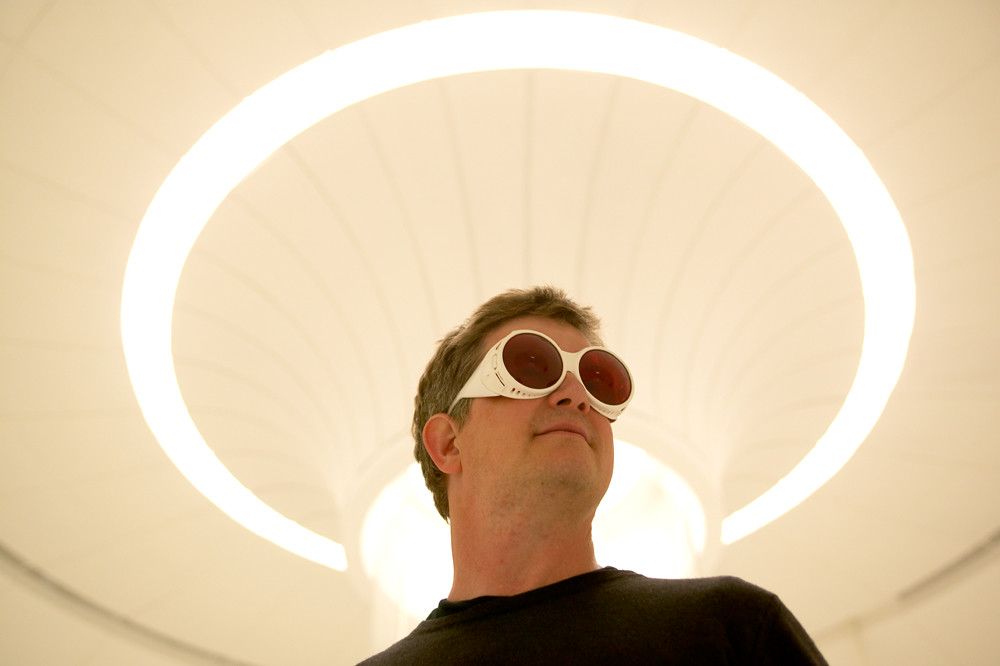
Alex McDowell sees his work as a film production designer as a form of painting in multiple dimensions. His unique and collaborative approach implicitly questions the accepted view of the insular workings of the auteur. Working on mainstream films in nearly every genre, including Fight Club, The Crow and Charlie and the Chocolate Factory, he builds virtual models for the construction of full-size sound stages and computer-generated imagery for post-production and he has pioneered digital tools to pre-visualise film sets, camera angles and shooting sequences, His experiences working with scientists and futurologists while researching the future world of Steven Spielberg’s Minority Report have inspired him to form Matter Art & Science, a virtual alliance of thinkers and practitioners across a diverse range of interrelated disciplines.
‘I am beginning to think that Matter is the real expression of co-ordinated thinking across all boundaries, not only within art, but in engineering, science and everything. I’m concerned with how a network co-exists. The raw materials of film are the people and the talent. Every film has the same opportunity to be good or bad. What’s different is the way that the social structure works.’
Yet in many ways McDowell has remained true to his roots in the turbulent days of London’s Punk scene. Back in 1975, while studying painting at the Central School of Art, he was involved in staging the first ever full concert by the Sex Pistols. Forging a friendship with Glen Matlock, he briefly printed t-shirts for Malcolm McLaren and Vivienne Westwood and then managed Matlock’s career for a short time. He set up Rocking Russian to design record sleeves for Matlock’s band Rich Kids, and later designed covers for Iggy Pop, Siouxsie & The Banshees and others. Assisting Terry Jones, he co-edited I-D magazine at its launch. By the early 1980s he had moved on to art-direct pop promos for hundreds of artists, including Madonna, and from there tv commercials for the likes of Levi’s and Nike. These were influential and formative years packed with energy, ideas, connections and openings. There was never any master plan: McDowell merely followed his instincts, immersing himself in each new creative challenge. Yet his work, while seldom displaying any obvious or overriding stylistic sensibility, has an overall conceptual framework that informs the varied projects that come his way.
For McDowell, seeing the Sex Pistols play was ‘a life-changing moment’. Until then, he had been making paintings that ‘were just about trying to shock people in the most extreme way possible’, but within Punk he instinctively saw a place of dissolving creative boundaries with few entry restrictions, where he could explore a more constructive yet no less rebellious way of working.
‘Coming from painting, my perception was that I was still a fine artist, but my translation into music, fashion and street culture was via an appreciation of Andy Warhol’s Factory. Rocking Russian was going to be the open network space that would be able to do whatever it wanted to do. It was a fine art project in the back of my mind. It wasn’t entrepreneurial – I knew nothing about business. There was a naive sense that you could launch off with the best creative intent and stuff would fall into place. We were surrounded by bands who’d picked up a guitar the week before and were producing records a week later. That’s the way the world worked. We didn’t have any frame of reference other than if you wanted it to happen, it would happen.
‘Whatever opportunity raised itself I took, because I couldn’t prioritise between them. I was equally interested in magazine design, releasing albums, selling T-shirts and designing record sleeves. It was all one big art project, and I continue like that to this day. In fact I am really back full circle now, to the point where I am really clear about the travesty of too much categorisation, too many sub-divisions of talent into speciality areas.’
A fortuitous opportunity in the mid-1980s landed him in Los Angeles for an initial extended period. He had gone over with director Peter Care to shoot a Bananarama video, but when that was cancelled they ended up with Robbie Neville instead. When Neville’s single went to number one, McDowell and Care were inundated with more work. For a lengthy period he was immersed in establishing himself on the West Coast, letting instinct guide him.
‘For a while, throughout maybe 1988 to 1990, I was jumping back and forth between commercials and music videos, working with David Fincher. I worked with him for almost a full year exclusively, seven days a week – he never stopped. It was at this point that I made the mental transition from music videos – quite small-scale, just do what you can with the money – to the whole process being practice for movie-making. Everything Fincher was doing was just a way of him honing his film-making muscle with outrageously complicated stuff. We did nine AT&T commercials, where the sets had only ten seconds of screen time in each, yet they were full movie sets. For him the whole thing was a showreel for movies, and it absolutely gave me the confidence when I was hired for my first movie.’
The Terminal, 2004. Directed by Steven Spielberg.
Top. Alex McDowell.
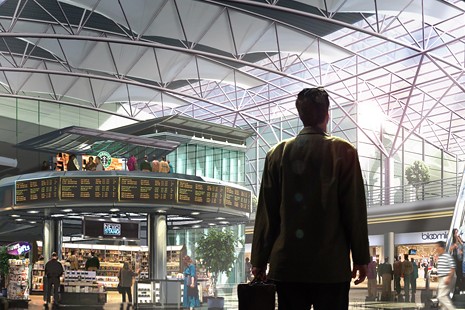
Recommended by one of the team who had also come over to shoot Bananarama, McDowell took on production design for The Lawnmower Man, a low-budget movie scripted by a Silicon Valley scientist and based on a reworking of a Stephen King novel. ‘The core ideas are interesting, in as much as they talk about virtual reality, but the budget was so low that you could just stumble your way towards solutions, so it was a great learning curve. Then I went back to commercials for nearly two years, because I just got offered a bunch of terrible B-movie sci-fi scripts.’ Again the chance element, coupled with McDowell’s growing skills in realising remarkable results with minimal budgets, had laid a useful grounding for the future.
For one who has allowed himself to be guided only by such career choices as presented themselves at the time, his ascent through the Hollywood network has shown remarkable prescience. A glance at his film credits reveals a diverse but curiously coherent portfolio. ‘Although I don’t know if it was very considered, the most valuable lesson I learned in film was that the only control you have in your career is what you turn down. And it is just luck what you get offered. In fact the next good thing offered to me was The Crow, directed by Alex Proyas, a commercials director who I already knew. It was another life-changing experience, and as commercials became less and less important for me, I was beginning to think of film as a full-time job.’
Fifteen years since this first foray into film, McDowell has now settled in Hollywood permanently and has forged a substantial career. He has worked on groundbreaking movies in both live action and animation with Terry Gilliam, Steven Spielberg and Tim Burton as well as Fincher. His designs have framed starring roles by Brad Pitt, Tom Cruise, Tom Hanks, Helena Bonham Carter, Johnny Depp and Brandon Lee (in The Crow). Earlier this year he was nominated for a BAFTA award for his remarkable production design for Charlie and the Chocolate Factory.
As his projects have increased in complexity, he has naturally advanced from the simple concept sketches for music promos to setting up large design departments for major multi-location productions. Concerned as much with story facilitation as with storytelling, a graphic design background has enabled him to organise large amounts of visual information. McDowell has also been quick to recognise the potential of digital tools in film. David Fincher introduced him to Previs (3D visualisation software used to mock up film environments) when they were working on Fight Club, and he has continued to develop and expand the usefulness of what he now calls ‘D-VIS’ (design visualisation) within the art department. Bringing together director, writer, cinema-tographer and visual effects at an early stage to plan in detail those aspects of the production which would be otherwise difficult to envisage, allows films to be developed in a practical, economic and visionary way. Although it is more than eight years since McDowell started using Previs, it has only recently become an industry buzzword, and most still use it inefficiently. One significant result of this approach has seen his art department become the natural operations centre throughout the whole of the production process.
The design workflow, set up during early pre-production, creates a circular flow of information throughout a wider range of processes. This drives the shooting and all aspects of post-production, breaking down the traditional divisions between departments, the results of which not only maintain the integrity of the look of the film, but also support a consistency of vision in photography, editorial and visual effects. ‘Film production is a highly complex machine designed to create a unique and coherent world for its audience,’ explains McDowell. ‘With technology changing at a rapid rate, the production designer has an increasingly central role in the new landscape of cinema. Progressive film design, using digital technology combined with traditional process and centralised in the art department, provides an unprecedented degree of control in the creation of a film.’
McDowell has not abandoned traditional methods, however, and he has strict guidelines regarding the effective and economic use of D-VIS. ‘There’s no point letting digital technology erase the memory of 100 years of expertise. The visual effects from the very beginning of film are still a resource in film in a way that they’re not in the real world. I think we’re trying to find a place where conventional and contemporary tools can co-exist. We’re just extending the range of tools we have with digital – and it’s a huge extension – but we’re not letting that wipe out existing tools.’ Paradoxically, this use of digital technology allows more visual solutions to be produced on set and thus remain ‘in-camera’, which is reflected in more believable results on screen.
McDowell continues: ‘There is no such thing as a “traditional” art director. It’s the job of an art director to stay current with all film-making processes. The heads of other departments can be Luddites if they choose, but it’s the art director’s job to coordinate all aspects of the film-making design process with full peripheral vision. If an art director chooses to stay “traditional”, that is in denial of one of the basic truths of film-making, which is that it is an art which is constantly reinventing itself. As a young medium it really doesn’t possess a traditional label at all.’
The results of D-VIS can be seen quite visibly in the distorted sets for The Cat in the Hat, or in the seamless integration of the Oompa-Loompas in Charlie and the Chocolate Factory. The technology was more subtly deployed in The Terminal, where the aim was to create such a realistic world that the viewer would not question it.
Minority Report (2002). Directed by Steven Spielberg.

The most significant career opportunity came when McDowell was appointed production designer for Steven Spielberg’s Minority Report. The film demanded the design of a believable future world that was genuinely visionary, yet sufficiently recognisable to a contemporary audience. Spielberg insisted that all of the technologies seen in the film, many of which are key to how the plot unfolds, were to be suitably advanced yet potentially realisable when projecting forward from the current understanding of science. ‘We had all sorts of theories of what would be cool but Steven wasn’t interested in anything that was cool for cool’s sake.’ To meet the challenge, McDowell enlisted the help of many scientists and futurologists, both as consultants and as a permanent part of the design team throughout the production.
‘Minority Report was an amazing opportunity, the importance of which I only fully registered halfway through the production. To work with Spielberg was another one of those life-changing things. He runs film production unlike anybody else, because he can. He has an absolutely dedicated crew whose members have worked with him for more than ten years. When you step in as a first-timer, you step into this well oiled machine and you have to hit the ground running.’
The initial task was to make real Spielberg’s vision of a non-dystopian world that we would all recognise, and that functioned well. ‘It hadn’t broken down, it wasn’t post-apocalyptic, it was green – it had all sorts of things working better about it than our world has. Very clearly Steven wanted to seduce the audience into wanting “Precrime” to be a good thing, not questioning the idea that the elimination of murder was a good thing. But he wanted at the same time, through the Tom Cruise character, the realisation that it was an abuse of civil liberties. That we should look around to check that that wasn’t happening in society right now. He wanted the audience split down the middle about how good Pre-crime really was, and relate it to its own situation.’
McDowell was hired the same day as the writer. There was no script – just a Philip K. Dick short story. This proved to be a defining factor that ensured that the design really influenced the film – possibly as much as the writing. By leaving space for the suggestion of technologies such as the gesture recognition interface and the mag-lev (magnetic levitation) cars, rather than being squeezed unrealistically into or around an existing script, the visual language and design components directly contributed to its development.
‘That iconic image of Tom Cruise conducting in front of the transparent screen came straight out of our development of a scientific and technical language for the script. At the beginning I didn’t know any of this stuff, but it became an extended framework for developing technology. We had a 75 per cent digital art department and we developed all the animation for post-production there. We had the science in-house and had full command over the film’s visual language in a way that had never been done before.’
Drawing influence from rigorous scientific thinking was an enlightening experience for McDowell, who as a result has formed Matter Art & Science, an expanding virtual group of designers, scientists, artists, engineers and film-makers. Besides the creative benefits, he wants this to be a way to address the lack of cross-fertilisation of experience that he sees in the film industry.
‘It’s terrible that there is such a low transfer of knowledge. People develop their own way of doing things, because when you are working on a film you live in a vacuum. We’ve evolved these hermetically sealed production bubbles which shut down completely every time a film is completed. You get very little continuity of information from one film to another, and in anyone’s career all you carry with you is what you have in your pockets and what’s in your head.
‘With Matter we’re aiming to filter what was perhaps the best aspect of the old studio system but in a virtual and flexible way. We’re creating a network archive, a pool of knowledge that anyone can dip into. Cinematographers, for example, have a real impetus to embrace technology because of the huge steps made with digital cameras.
‘The larger films develop new technology more rapidly but they are also separate from one another, often because of studio security issues. They may have some secret technology, or there is an aspect of the marketing campaign which they don’t want people to see yet.’
Charlie and the Chocolate Factory (2005). Directed by Tim Burton.
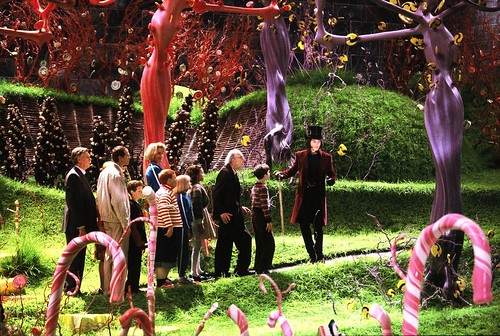
For a multi-disciplinary visionary like McDowell, collaborative and integrated thinking is rewarding. ‘The film production designer creates a fully developed immersive world for the audience, seamlessly weaving setting with narrative so that the audience remains immersed in a film, and on each re-visit is able to delve deeper into the experience. Where I have been able to develop design ideas either in advance of, or simultaneously to, a film script, the story has been enhanced by being placed squarely in an already imagined world space.’
Until recently McDowell was sceptical of interactive storylines. This has changed following work last year with writers and game designers who are developing truly interactive worlds that could be inhabited and continue to evolve for years. ‘For a designer this is a fascinating prospect – to create an immersive world where the environment itself is the main trigger for a story, where there is no place for linear narrative when 1000 players may inhabit virtual space simultaneously. The Minority Report think-tank suggested that designers, artists and craftsmen would have an increased value to future society. It turns out they may be right.’
‘I have always been interested in the edges of things, the places that exist between and adjacent to those places of identifiable genre and style. In the late 1970s I went from fine art to graphics to music to film at a time when all the rules were being thrown into the air. Again we find ourselves in a time of uncertainty, but this time created by accelerated technology, rather than Punk. It is time to start gravitating back towards the edges, where maximum convergence is occurring. I feel very fortunate to be working in such a place, in proximity to the chaos.’
The Terminal (2004). McDowell’s set for Spielberg’s The Terminal required the construction of a huge airport, which he describes as one of the film’s key characters. Digital set design liberated the film-making process.
The Crow, 1994. Personal experience informs McDowell’s work. The house in Fight Club (1999) ‘was really close to a squat in Stoke Newington that I lived in when I was at art college’. A tour of downtown Detroit during pre-production for The Crow (right) provided inspiration for both movies.
The Cat in the Hat, 2003, directed by Tim Burton. These sets show how McDowell uses digital technology to visualise ‘impossible’ locations, sets and props, and then to go on to construct them for real, rather than rely on computer-generated post-production techniques. ‘Because I am coming at the craft of film design from the point of view of a fine artist, my own view is one that allows me to be as interested in the process as the result, if you like. And I am increasingly seeing the process as part of the craft.’
Minority Report (2002). McDowell explains: ‘Because of Spielberg’s demand for a science-based future reality, we were forced to look outside our own film resources.’ Think-tank workshops (in LA and at MIT) pooled the thinking of dozens of scientists with that of McDowell’s team.
Charlie and the Chocolate Factory, 2005. McDowell says: ‘The stark Constructivist / Futurist / Brutalist factory design came from the need to provide contrast with the colours and child-centric overtones of the candy and chocolate. CGI was employed most intensely around the Oompa-Loompas. The 30-inch tall Oompas were played by actor Deep Roy, who was shown in ways that involved over-scaled sets, bluescreen, motion capture, CG and all aspects of design craft and trickery.
Malcolm Garrett, creative director, London
First published in Eye no. 60 vol. 15 2006
Eye is the world’s most beautiful and collectable graphic design journal, published for professional designers, students and anyone interested in critical, informed writing about graphic design and visual culture. It is available from all good design bookshops and online at the Eye shop, where you can buy subscriptions, back issues and single copies of the latest issue. You can also browse visual samples of recent issues at Eye before You Buy.

